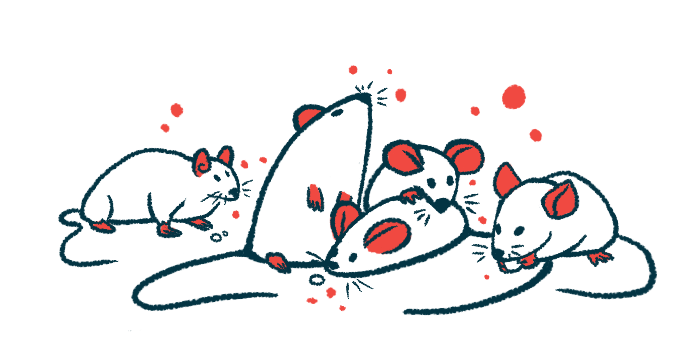Used in Alagille mice, ASO therapy found to improve liver function
Lab results support treatment's development for human liver disease

An experimental antisense oligonucleotide (ASO) therapy designed to boost production of the Jagged-1 protein — which is known as Jag1 in mice and JAG1 in humans, and deficient in most cases of Alagille syndrome — improved bile duct development and liver function in a mouse model of the disease, a study showed.
ASO therapies influence protein production by targeting the target gene’s messenger RNA (mRNA), an intermediate molecule derived from DNA that is used as a template for protein production.
“The results observed in this study support further development of ASOs that directly increase JAG1 protein in the liver as a therapeutic strategy to treat [Alagille syndrome] liver disease,” the team of researchers, from Arnatar Therapeutics, wrote in a study detailing their findings.
That study, “Antisense oligonucleotide-mediated upregulation of Jag1 ameliorates liver disease phenotypes in a mouse model of Alagille syndrome,” was published in the journal Molecular Therapy Nucleic Acids.
ART104, Arnatar’s ASO therapy candidate for Alagille, is now in early clinical testing. The first participant was dosed with ART104 in an investigator-initiated clinical trial involving Alagille patients.
A rare genetic condition, Alagille can affect the development of several organs and systems in the body, including the liver.
Liver problems are often caused by fewer bile ducts — the tubes that carry the digestive fluid bile — inside the liver. This results in slowed or stalled bile flow, a condition called cholestasis, and bile buildup in the liver, which can disrupt its function and lead to tissue scarring and liver failure.
Seeking to increase production of the lacking JAG1 protein
Mutations in the JAG1 gene, which contains instructions for producing the JAG1 protein, are the most common cause of Alagille. While people with the condition typically have one working copy of the JAG1 gene, production of JAG1 isn’t sufficient to support proper development.
“Therefore, directly increasing JAG1 protein provides an attractive strategy to treat [Alagille syndrome] from the root,” the researchers wrote.
In this study, the research team from Arnatar tested several ASOs designed to increase JAG1 production, measuring their effects in various cell and animal models. Each candidate molecule targeted different parts of the JAG1 mRNA, with different results.
Experiments in lab-grown cells indicated that “ASOs targeting different regions of JAG1 mRNA can increase the protein level in both normal cell lines and [Alagille] patient cells,” the team wrote.
Directly increasing JAG1 protein provides an attractive strategy to treat [Alagille syndrome] from the root.
One ASO that boosted protein JAG1 production, called ATXL212, emerged as a strong candidate. The researchers then modified it in ways they hypothesized would improve delivery to liver cells in living animals. The resulting ASO was named ATXL233.
In healthy mice, subcutaneous, or under-the-skin, injections of ATXL233 resulted in an increase of as much as 190% in levels of Jag1 in the liver. In comparison, ATXL212 treatment led to a 150% increase in Jag1 levels, even when used at higher doses than those of ATXL233.
These results indicated that ATXL233 modifications notably improved the ASO’s effects, allowing also the use of lower effective doses.
In mice treated twice a day with ATXL233 for four days, Jag1 levels remained high three weeks after the first treatment injection, suggesting sustained effects.
Treated mice showed fewer bile duct abnormalities
Various blood tests and organ examinations did not identify negative impacts of the experimental treatment. These findings indicated ATXL233 was “tolerable and potentially safe for in vivo [in living animals] therapeutic treatment under the experimental conditions tested,” the team wrote.
Next, the researchers tested ATXL233 in a mouse model of Alagille, which had approximately 25% as much Jag1 as healthy animals. Twice-daily treatment over four days increased Jag1 levels to 60% of those seen in healthy mice, “suggesting a therapeutic potential to treat [Alagille],” the team wrote.
Alagille mice treated once a week for three weeks showed fewer bile duct abnormalities, with a significant increase in bile duct number relative to untreated mice. ATXL233-treated mice also showed a trend of reduced liver scarring and lower levels of several markers of liver damage.
Taken together, these results demonstrate the potential of ASOs to target JAG1 and potentially ease symptoms of Alagille, according to the researchers.
“Since [bile duct] development is a relatively slow process, it is possible that more prolonged ASO treatment may cause more profound [benefits],” the team wrote.
Future studies will need to investigate the mechanisms by which ASOs like ATXL233 affect the liver, according to the researchers. The scientists also noted that “it is unknown how long the improved [bile duct] can be maintained and whether continued ASO dosing is required once the [bile duct] is restored.”
This preclinical study supports further development of JAG1-targeting ASOs for Alagille, including ongoing clinical testing of Arnatar’s ART104, per the researchers.
ART104 was granted orphan drug and rare pediatric disease designations in the U.S. in September. These statuses are meant to accelerate a therapy’s clinical development and regulatory review.






